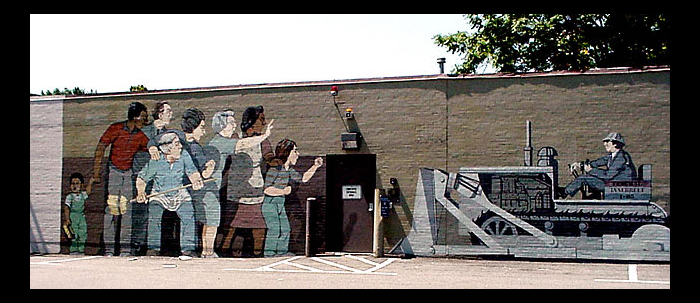Beat the Belt

Assessing Bernard LaCasse’s Beat the Belt Mural
Conservation Assessment of Bernard LaCasse’s Beat the Belt Mural in Cambridge
730 Memorial Drive (rear of building)
Accession #: CAC80.09
Acrylic on painted brick
History
The "Inner Belt" was a proposed eight-lane highway that would have run right through the neighborhood of Cambridgeport. Local residents battled the highway for 20 years before winning the fight in 1970. Bernie LaCasse's mural, completed in 1980, commemorates this moment of triumph, celebrating the power of ordinary people to make a difference. The Cambridge Arts Council’s public art archive contains files on the early history of the mural. At that time, the artist noted the important work of the steering committee and the number of people who assisted him on the project. He wrote: “I feel the process was as important as the final artwork”.
Previous Re-Painting
By 1995, the color had faded, and that year the artist repainted the mural with a grant from Stop & Shop, the building occupant at that time. The mural remained in good condition for a number of years, but some fading and flaking paint was noted in the year 2000. Since 2000, the Art Conservation Program has annually monitored the mural. During these inspections, dirt and accretions removed by a gentle detergent and water.
Current Condition
In 2003, after further flaking was noted, a freelance painting conservator was asked to assess the condition of the mural. The conservator’s report noted water damage from the leaking roof above, and water damage on the right side due to the poor condition of the flashing. There were also abrasions to the panel caused by car parking. In the ensuing years, more flaking has been noted. By 2008, severe fading was noted, and in 2013, graffiti (in the form of a letter “B”) was found spray painted at the upper right. In 2015, the art conservation program determined that an in-depth assessment was needed.
The Art Conservation Mural Assessment will be carried out on Thursday November 17, by Rika Smith McNally, the Director of Art Conservation at the Cambridge Arts Council, Liza Leto-Fulton, freelance paintings and murals conservator, and Nichole Speciale, freelance conservation technician and collections care specialist.
For the assessment, we will be considering the following questions:
- Is the paint layer in such poor condition that it cannot be repainted?
- Can the current flaking paint be stabilized? Can the losses be filled, and if yes, what with?
- Are there any mitigating steps we can take to lower the amount of moisture entering the concrete block?
- Should we attempt to repaint the mural, and if so, can we get approval from the artist?
- What materials would be best for repainting, if that is considered? What varnish?
- If we repaint, how long can we expect this iteration of the mural to last?
- Are the Hubway Bicycle racks protecting or hindering the preservation of the mural?
- Have there been other projects like this elsewhere in the United States, in which a second repainting was successful?
- The final report with recommendations and budget estimates is expected by early February 2017.